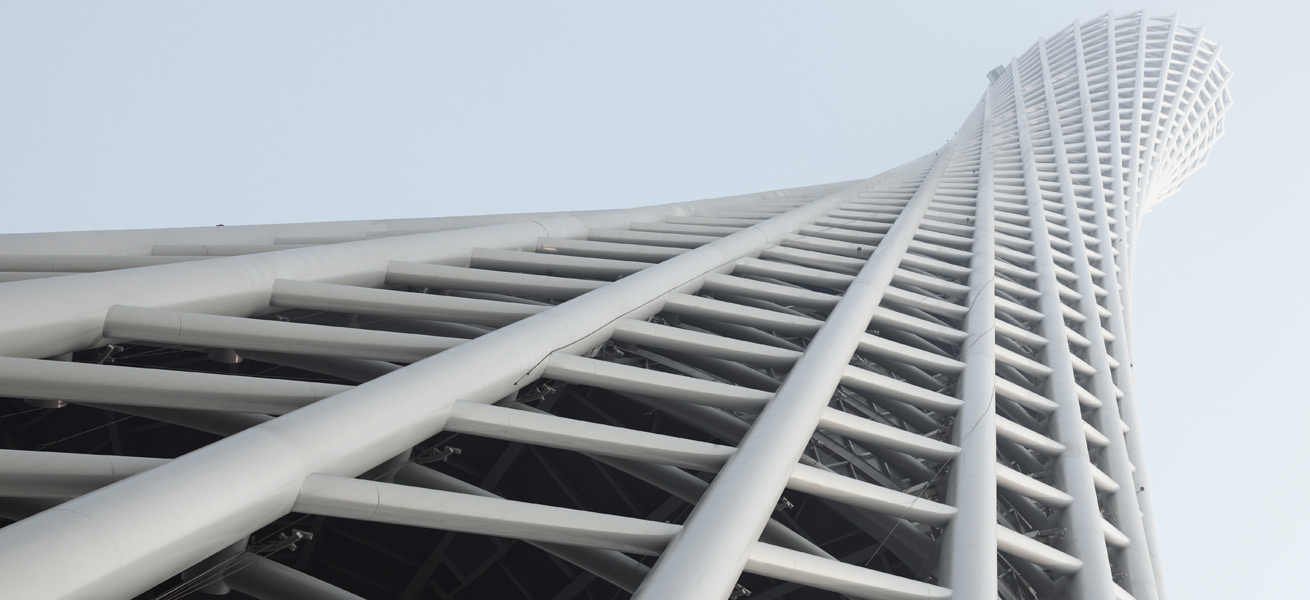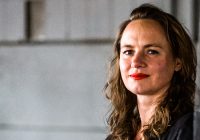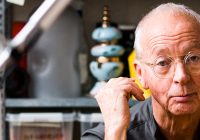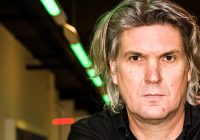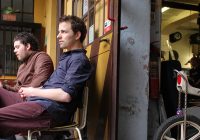Designer of the Canton Tower Mark Hemel has decided Guangzhou is the place to move forward with family and career. He talks to Xu Jingxi in Guangzhou. He had looked at more than 50 apartments before settling for the one he now lives in with his wife and three children. That’s because this one has a great view of his best work in the city. “Canton Tower looks beautiful from this angle,” Dutch architect Mark Hemel says, as he stands in the garden of his new home.
Interview with Mark Hemel
Text by Xu Jingxi(许靖烯)
Translation by Xiyang Wang(王兮杨)
“It is the landmark of my career,” continues Hemel, who completed the design of the 600‐meter‐high Guangzhou TV & Sightseeing Tower in 2004, together with Barbara Kuit.
“I had never participated in such a big and complex project before. Almost every architect dreams about designing a city landmark.”
In August 2011, the 46‐yearold architect, who has grown attached to the Guangzhou landmark and the city, made a decision. He moved his family from Amsterdam to Guangdong’s provincial capital.
“The project is meaningful not only to my career but also my life. I have devoted eight years of my life to it,” says the architect, who’s known for his unconventional designs, best exemplified by the Canton Tower.
It has the smooth elegant silhouette of a woman keeping vigil by the Pearl River, the city’s mother river.
Now that Hemel has achieved his dream of designing a city icon, he wants to move on to other projects and a chance to design culturally significant buildings like museums and theaters. He is convinced China is where he will get the best opportunities.
Propelled by rapid economic growth, the country has become the promised land for architects around the world. New landmarks are mushrooming in major cities, and many bear the signatures of foreign architects.
Besides Hemel’s 2.95‐billionyuan ($460‐million) Canton Tower, Swiss architects Jacques Herzog and Pierre de Meuron helped design the Beijing National Stadium, or Bird’s Nest, the centerpiece of the 2008 Beijing Summer Olympics.
American architect Steven Holl’s Vanke Center in Guangdong’s Shenzhen was completed in 2009, and Japanese architect Tadao Ando’s latest creation, Shanghai’s first lakeside theater, is set to finish construction in 2013.
“People in fast developing countries are open to state‐of‐the‐art architectural designs,” says Vincent Lam Siu‐yu, project manager at Arup Group Limited, an engineering consulting firm that worked with Hemel during the Canton Tower project.
“Architects can give full play to their creativity here in China.” Hemel first went to Guangzhou on his honeymoon tour of Asia in 1995. Even then, he was already impressed with the city’s vitality.
“Guangzhou is dynamic. It’s constantly changing and reinventing itself,” he says.
“Seeing construction springing up across the city made me believe that I could find plenty of opportunities here.”
When he heard in 2004 that Guangzhou was launching an international search to design its landmark high‐rise, Hemel immediately submitted his pitch.

Canton Tower
Three years after its completion, the Canton Tower still plays an important role in Hemel’s daily life. It’s a solid testimony to his talents.
He still gives presentations at the tower, and prospective clients always ask to see it.
For Hemel, moving his family to Guangzhou was “a gamble”, but it was a calculated risk.
“I don’t know whether I will have as many opportunities as I hope,” he says.
His success with the Canton Tower has become a double‐sided sword to the architect’s career.
Job offers come in, and Hemel gets at least one a month, according to Shen Bin, his assistant in Guangzhou. But, according to Lam from Arup, Hemel is also struggling to find new directions.
“Many clients ask him for designs similar to the Canton Tower’s,” Lam explains.
“But while architects sometimes refuse repetition and long to innovate, few clients are able to support this ideal.”
There are also other hurdles. He admits he has had trouble networking with other architects in China.
“In Amsterdam, basically all the architects work in the same building in an artistic community,” he says.
“In China, architects and engineers are scattered, so I felt a bit isolated.”
But he is trying his best to adapt to the Chinese style of networking.
“I attend networking banquets in China more often than I did in the Netherlands,” he says.
“It’s interesting that Chinese love to take turns toasting you.”
He once had to drink 40 shots of liquor during one dinner because everyone wanted to drink with him.
Shen, Hemel’s assistant, says the architect goes to at least five networking events a month.
“It is necessary, especially if we want an edge over local companies,” Shen says.
“In China, the client sometimes chooses a design because he knows the architect well.”
It may take time for Hemel to understand the intricacies of Chinese culture, but he’s enjoying the journey. He and his family travel a lot, often to marvel at China’s diverse vernacular architecture.
Hemel says he and his wife Barbara Kuit, who’s also an architect and worked with him on the Canton Tower project, are most impressed by the tulou, or the circular communal buildings built by the Hakka people of Fujian province.
“The local people designed and built these, which are not only beautiful but also environmentally intelligent,” Hemel says.
Hemel says such wisdom from vernacular architecture not only inspires him but also gives him a better understanding of Chinese culture, which he hopes will give him an advantage when it comes to pitching new projects in China.
According to Patty Lui Yuen Man, Hemel’s assistant during the Canton Tower project, this is an important factor.
Hemel’s design of the Canton Tower won over the client because of its concept of a fair lady overlooking the Pearl River. The presentation struck a chord because Guangzhou’s citizens have great affection for their mother river.
After nearly a year, Hemel and his family are slowly getting used to life in China.
Zoe, an outgoing 9‐year‐old who’s the family’s eldest child, has been quick to learn Chinese and was recognized by her school for her progress.
Nina, his 7‐year‐old daughter, also tries to teach her parents a little Chinese. Their little brother Liam, 6, enjoys skating in the city’s open square a lot.
Hemel himself has a long list of what he loves about China: Chinese people are friendly to newcomers. People give seats to the elderly on the bus. And, above all, Chinese food pampers his palate.
“I don’t know the result of my gamble in moving my whole family to China, but I’m sure at least that my children will earn some useful luggage for their future journeys,” the father says.
His wife, who supported her husband’s decision to move, hopes her kids can learn from their time in Guangzhou.
“The children are being exposed to a different culture and lifestyle, and will become more open‐minded and better able to handle new environments in the future,” she says.
Hemel says that, if anything, the move has made his family closer.
“Living in China has made us conscious about the importance of family,” he says.
“It is difficult to adapt to all the differences in a new city, but as a family we handled it. We stay together and support each other.”
This article was previously published in the newspaper China Daily July 3, 2012 www.europe.chinadaily.com.cn and re-published in Connecting the Dots #6 for the Guangzhou Design Week and the Business of Design Week edition in 2012.
For entire magazine click here.

Canton Tower by Information Based Architecture
广州电视观光塔的设计师马克·海默尔决定把广州作为他安家立业之处,海默尔在广州接受中国日报记者许靖烯采访时这样表示。
他在看过超过50套公寓后最终选定了这所现在他与夫人和三个孩子居住的公寓。原因是这套公寓有供他欣赏这座城市中他最杰出作品的视野。当海默尔站在新家花园中时,这位荷兰建筑师感叹到:“从这个角度看,广州电视塔美极了。”
2004年,海默尔与夫人芭芭拉·库伊特一同完成了600米高的广州电视观光塔的设计。“它是我职业生涯的里程碑,” 海默尔接着说。
“我过去从未参与过如此大型和复杂的项目。几乎每一个建筑师都梦想着设计一座城市地标性建筑。”
2011年8月,这位46岁的建筑师因十分留念广州这座城市和这座标志性建筑作出了一个决定,将全家从荷兰阿姆斯特丹搬到了广东省省会城市广州。
这位以标新立异设计著称的、以广州电视塔设计为其最佳代表作的建筑师说:“这个项目对我的职业生涯和我的生活都有重要意义。我在此项目上倾注了八年的心血,”
这座建筑宛如一位身段流畅优雅的女子守护着珠江,这座城市的母亲河,江畔的夜色。
如今,海默尔已经实现了设计一座城市地标的梦想。接下来他打算进行其他的项目,并有机会去设计有文化意义的建筑,如博物馆和剧院。他深信中国是他能够得到最好机会的地方。
在经济快速增长的推动下,中国这个国家已经成为世界各地建筑师的“乐土”。新的标志性建筑如雨后春笋般在各大城市兴起,这其中有很多是出自外国建筑师之手。
除了海默尔设计的总投资约29.5亿元人民币(约4.6亿美金)的广州电视塔外,瑞士建筑师雅克·赫尔佐格和皮埃尔·德梅隆帮助设计了2008年北京夏季奥运会的核心建筑——北京国家体育馆(又名鸟巢)。
美国建筑师史蒂芬·霍而设计的广东深证万科中心已于2009年完工。日本建筑师安藤忠雄的最新作品,上海首座湖畔剧院,将于2013年完成建设。
英国奥雅纳(Arup)集团有限公司(与海默尔一同参与广州电视塔项目的工程顾问公司)项目经理林少羽(文森特)说:“快速发展国家中的民众愿意接受最先进的建筑设计。”
“在中国,建筑师可以充分的发挥他们的创造力。” 海默尔第一次到广州是在他1995年的亚洲蜜月之旅中。即使在当时,这座城市的活力就给他留下了深刻印象。
他说:“广州是一个动态的、不断变化的城市。这个城市不断地改变和重塑自己,”
“当看到这座在迅猛建设中的城市时,我确信自己在这里能够找到很多的机会。”
2004年,当海默尔获悉广州市正准备启动一项针对高层地标建筑设计的国际招标时,他立即提交了自己的方案。
竣工之后三年,广州电视塔依然在海默尔日常生活中起着重要作用。这座建筑是对他设计才能的坚实见证。
他仍然会在电视塔那里介绍这座建筑,一些潜在的客户总会要求一观其貌。
对于海默尔来说,举家搬到广州如同“一场赌博”,但却是值得的。
他说:“我不知道是否可以如自己希望的那样得到很多机会,”
他在设计广州电视塔上取得的成功变成了这位建筑师职业生涯中的一把“双刃剑”。
据海默尔在广州的助理沈斌所说,设计项目接踵而至,海默尔一个月内至少能够接到一个项目。但是,据奥雅纳(Arup)集团有限公司项目经理林少羽介绍,海默尔也正在努力寻找新的方向。
林少羽解释说:“很多客户要求他做出与广州电视塔相似的设计,”
“但建筑师们往往拒绝重复,渴望创新,很少有客户能够支持这样的理想。”
此外,还有其他的障碍。海默尔承认他在结识中国其他建筑师方面遇到了麻烦。
他说:“在阿姆斯特丹,基本上所有的建筑师在一个艺术社区中的同一栋楼里面工作,”
“而在中国,建筑师和工程师都是分散的,所以我觉得有点孤立。”
然而,他在尽自己最大的努力去适应“中国式”的社交。
他说:“我在中国参加的社交宴会比在荷兰时要多。”
“有趣的是,中国人喜欢轮流来与你敬酒。”
他曾经在一顿晚餐中喝了40杯酒,那是因为席上每一个人都想要与他喝酒。
海默尔的助理沈斌说,一个月内他至少要参加5场社交活动。
沈斌说:“这是必要的,特别是当我们想要胜过当地的设计公司,”
“在中国,有时客户选择一个设计是因为他很熟悉这个建筑师。”
对海默尔而言,可能需要一段时间来了解中国文化的复杂性,但他乐在其中。 他与家人去过很多地方,常常惊叹于中国形形色色的乡土建筑。
海默尔表示,他与跟他一同设计广州电视塔的建筑师夫人芭芭拉·库伊特都对福建土楼,这种由福建省客家人兴建的圆形公共建筑,印象最为深刻。
海默尔说:“当地人设计并建造这些土楼,它们不仅美观而且环保,”
海默尔说,这些乡土建筑中所反应出的智慧不仅启发了他,同时能够让他更好的了解中国的文化。他希望这些收获能够使他在中国开展新的设计项目时成为一种优势。
海默尔在进行广州电视塔项目期间的助理呂婉曼(帕蒂)认为,这是一个重要的因素。
海默尔设计的广州电视塔赢得了客户的青睐,这是因为广州电视塔的设计概念旨在表现一位窈窕淑女俯瞰珠江。由于广州市民对他们的母亲河有着深厚的感情,因此这种表达引起了共鸣。
经过近一年的时间,海默尔和他的家人慢慢习惯了在中国的生活。
佐伊,一个外向、开朗的9岁女孩,在家中孩子们当中她年龄最大,已经在快速的学习中文,在学校,她所取得的进步也是公认的。
妮娜,海默尔7岁的女儿,也试着教她的父母一点点中文。她们的弟弟利亚姆,今年6岁,非常喜欢在城市的露天广场溜冰。
有很多原因让海默尔喜爱中国:中国人对新客人很友好。人们在公共汽车上给老人让座。而且,最重要的是,他对中国美食青睐有加。
这位父亲谈到:“举家搬到中国就像是我生命中的一场赌博,我并不知道结果会如何,但是我敢肯定,至少我的孩子们将会收获对他们未来人生旅程有用的东西。”
海默尔的夫人支持丈夫搬到中国的决定,并希望她的孩子们可以从生活在广州的日子中进行学习。
她说:“孩子们正接触着不同的文化和生活方式,他们的思想会变得更开放,在未来能够更好的应对各种新的环境。”
海默尔说,总之,举家搬到广州让他的家人更亲密。
他说:“生活在中国让我们意识到家庭的重要性,”
“要适应一个新城市中各方面的差异是不容易的,但作为一个家庭我们能够应对。我们生活在一起并相互支持。”

